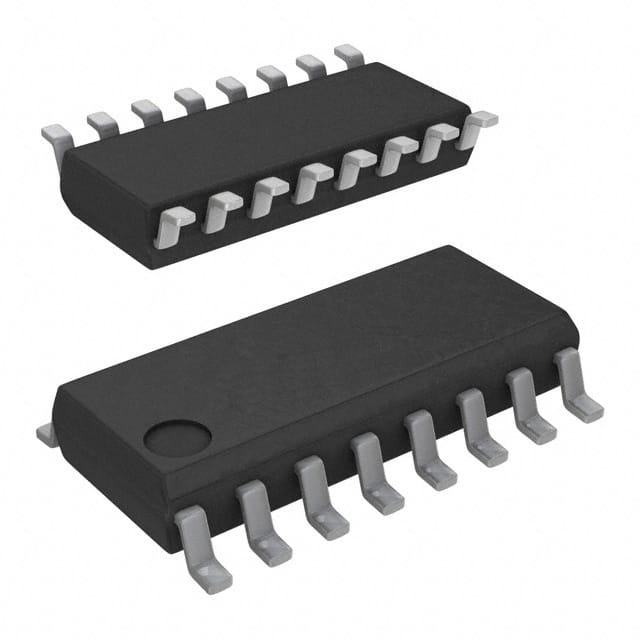Xem thông số kỹ thuật để biết chi tiết sản phẩm.

SN74HC158DR
Product Overview
- Category: Integrated Circuit (IC)
- Use: Data Selector/Multiplexer
- Characteristics:
- High-speed CMOS logic
- 2-input multiplexer with common select input
- Wide operating voltage range: 2V to 6V
- Low power consumption
- Schmitt-trigger inputs for noise immunity
- Package: SOIC (Small Outline Integrated Circuit)
- Essence: SN74HC158DR is a versatile data selector/multiplexer IC that allows the selection of one of two data inputs based on a common select input.
- Packaging/Quantity: Available in reels of 2500 units.
Specifications
- Supply Voltage Range: 2V to 6V
- Input Voltage Range: 0V to VCC
- Output Voltage Range: 0V to VCC
- Operating Temperature Range: -40°C to +85°C
- Propagation Delay Time: 9 ns (typical)
- Maximum Quiescent Current: 1 μA
- Maximum Output Current: ±25 mA
Pin Configuration
The SN74HC158DR has a total of 16 pins, which are assigned specific functions as follows:
- A Input 1
- B Input 2
- C Select Input
- Y Output
- GND Ground
- Y Output
- D Input 3
- E Input 4
- F Select Input
- Y Output
- VCC Power Supply
- Y Output
- G Input 5
- H Input 6
- I Select Input
- Y Output
Functional Features
- The SN74HC158DR is a 2-input multiplexer with a common select input.
- It allows the user to choose between two data inputs (A and B) based on the select input (C).
- The selected data is then available at the output pin (Y).
- The IC operates with high-speed CMOS logic, ensuring fast and reliable data selection.
- Schmitt-trigger inputs provide noise immunity, making it suitable for noisy environments.
Advantages and Disadvantages
Advantages: - High-speed operation - Wide operating voltage range - Low power consumption - Noise immunity due to Schmitt-trigger inputs - Versatile data selection capabilities
Disadvantages: - Limited to 2-input multiplexing - Not suitable for applications requiring more than two data inputs
Working Principles
The SN74HC158DR works by utilizing a combination of logic gates and multiplexing circuitry. When the select input (C) is set to logic low (0), the data input A is selected and passed through to the output pin (Y). Conversely, when the select input is set to logic high (1), the data input B is selected and passed through to the output. The IC operates on the principle of digital logic, where the select input determines which data input is chosen.
Detailed Application Field Plans
The SN74HC158DR can be used in various applications, including but not limited to:
- Data routing and switching systems
- Digital signal processing
- Communication equipment
- Industrial automation
- Consumer electronics
- Automotive electronics
Detailed and Complete Alternative Models
- CD74HC157E: 4-line to 1-line Data Selector/Multiplexer
- MC74HC153N: Dual 4-line to 1-line Data Selector/Multiplexer
- SN74HC151N: 8-line to 1-line Data Selector/Multiplexer
- CD74HC238E: 3-to-8 Line Decoder/Demultiplexer
These alternative models offer similar functionality to the SN74HC158DR and can be used as substitutes depending on specific application requirements.
In conclusion, the SN74HC158DR is a versatile data selector/multiplexer IC that provides high-speed operation, wide voltage range, and low power consumption. Its compact SOIC package makes it suitable for various applications in different industries. However, its limitation to 2-input multiplexing may restrict its use in more complex systems requiring multiple data inputs.
Liệt kê 10 câu hỏi và câu trả lời thường gặp liên quan đến ứng dụng SN74HC158DR trong giải pháp kỹ thuật
Sure! Here are 10 common questions and answers related to the application of SN74HC158DR:
Q: What is SN74HC158DR? A: SN74HC158DR is a quad 2-input multiplexer IC (Integrated Circuit) that can be used in various technical solutions.
Q: What is the purpose of SN74HC158DR? A: The purpose of SN74HC158DR is to select one of four input signals and route it to the output based on the control inputs.
Q: What is the voltage range supported by SN74HC158DR? A: SN74HC158DR supports a voltage range of 2V to 6V.
Q: How many control inputs does SN74HC158DR have? A: SN74HC158DR has two control inputs, which determine the selection of the input signal.
Q: Can SN74HC158DR be used for analog signals? A: No, SN74HC158DR is designed for digital signals and is not suitable for analog applications.
Q: What is the maximum operating frequency of SN74HC158DR? A: The maximum operating frequency of SN74HC158DR is typically around 50 MHz.
Q: Can SN74HC158DR handle high-speed data signals? A: Yes, SN74HC158DR is capable of handling high-speed data signals due to its fast switching characteristics.
Q: Does SN74HC158DR have any built-in protection features? A: SN74HC158DR does not have built-in protection features, so external measures may be required to protect against voltage spikes or ESD (Electrostatic Discharge).
Q: Can SN74HC158DR be used in battery-powered applications? A: Yes, SN74HC158DR can be used in battery-powered applications as it operates within a wide voltage range.
Q: Are there any alternative ICs to SN74HC158DR? A: Yes, there are alternative ICs available from different manufacturers that perform similar functions, such as 74HC157, CD4051, or MC14051B.
Please note that the answers provided here are general and may vary depending on specific application requirements. It is always recommended to refer to the datasheet and consult with technical experts for accurate information.

